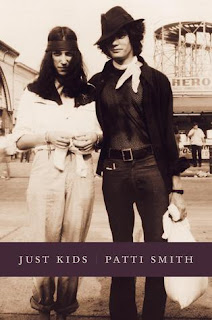Genre: Memoir
Author: Patti SmithPages: 304 pages
Year of Publication: 2010
Publisher: Harper Collins
Synopsis:
In Just Kids, Patti Smith's first book of prose, the legendary American artist offers a never-before-seen glimpse of her remarkable relationship with photographer Robert Mapplethorpe in the epochal days of New York City and the Chelsea Hotel in the late sixties and seventies. An honest and moving story of youth and friendship, Smith brings the same unique, lyrical quality to Just Kids as she has to the rest of her formidable body of work--from her influential 1975 album Horses to her visual art and poetry.
*
My heart glows and is cleansed after reading the book. I admire the life and the ideals that Patti Smith led. Indeed, it is a very fascinating life. Let me tell you why.
Just Kids is a homage that Smith wrote in honor of Robert Mapplethorpe. The two first met in Brooklyn, New York as some sort of vagabonds, both were in their early twenties and knew what they wanted to do in their lives: doing art. So, they spent the next years by devoting their lives to it. Nevertheless, entering the art scene while also having a financial strain during the seventies was not easy for them.
Still, they were very confident in their aspiration to art. Talking about Smith and Mapplethorpe’s relationship is a tricky yet a lovely matter. They were lovers, best friends, and colleagues. They still remained as best friends who give feedback to each other’s artworks even after they stopped sharing a bed together. Now, this is when things got quite messy. Mapplethorpe firstly fell in love with drawing and handcrafting such as making a necklace. Later, as he grew frustrated with his sexuality, he picked up photography. Not only his medium of art that changed, the theme depicted in his works also drifted. At first, Mapplethorpe was obsessed with the Church and religion themes. As he entered the underground sadomasochism scene, his works became closer to the exploration of sex and his own sexuality.
While Mapplethorpe explored the nature of his artworks and his sexuality, he found himself engaged in a romantic partnership with a man. Smith, who knew this all along, remained calm and wise. It seems to me that their relationship was never defined by a single line, they were very open to people and ideas. As their bond as lovers drifted apart, they were united by their artworks. Smith with her poetry and drawing, and Mapplethorpe with drawing and photography. Throughout the decades, they paved their separate ways into the art world. In the end, although Mapplethorpe seems like the ambitious one in pursuing his dream, it is Smith whose works more popular than Mapplethorpe’s in the next century. One of the causes of this was Mapplethorpe’s death that came way too early.
Reading this book, I could not stop wondering how Smith is so spontaneous, and somewhat ‘present’, in her approach toward her life. The seventies was a tumultuous year, with the counter-culture movement like hippies, the resurgence of Beat lifestyle, women’s liberation movement, to name a few, as reactions to post-World-War America. Yet, despite this age of uncertainty, Smith seems not to be so bothered. Additionally, I found her commitment to not taking drugs and addictive smoking a striking difference with the people and culture she surrounded herself with.
Sure, Smith is gifted with her deft writing that evokes a certain poetic feeling in which I am so immersed in her world. Even so, I found the middle third of the book lost its charm as it gets repetitive and tedious. There was a lot of name-dropping in that section, which I easily forget as I move into the next section. Not only that, the pacing of that part was rushed.
Another thing that I think Smith could do better at is how she actually felt toward all those changes she went with Mapplethorpe, particularly the new partners Mapplethorpe had and his hustling life. Those parts were not exposed so much in the book, though Smith was so open in portraying Mapplethorpe as he was. In this way, Smith is very careful in sharing her own feelings on that all.
I am sure that Smith did that intentionally with a sound reason in mind. As I recently watched her interview in Louisiana, Denmark in which she talked about this book, she revealed that writing this memoir took so many years for her. Mapplethorpe died in 1989, and the memoir, in which Smith was requested by Mapplethorpe to write it, only came out in 2010. Smith explained that in between those years, she has lost so many people in her life that writing about one of them--Mapplethorpe--relives the memories that she had of him. In addition, Smith admitted that in the process of writing the book, she was so considerate as how she portrayed the people in her life.
In the end, I found myself so emotional toward the end of the book that I shed tears. Seeing how Smith and Mapplethorpe’s relationship grew closer and apart, I truly admire the liberating and wise way Smith approached on important aspects of her life. While I am also aware that some reviewers have called her naive for having this kind of approach, I have to disagree on that. I see that Smith’s openness and positive outlook toward life as something that cultivates a sense of hope in me. In this age of endless violence and anxieties, it is easy for one to despair and see life with contempt and bitterness. Patti Smith reminds me that you could live your life to the fullest without removing your innocence to the little surprises that the world has to offer to you.


No comments:
Post a Comment